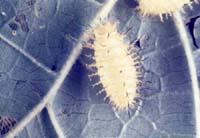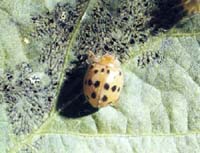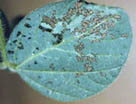Mexican Bean Beetle
Epilachna varivestris

Figure 1. Mexican Bean Beetle Larva
Description
Newly emerged adult Mexican bean beetles are
round, about 1/4 inch long, and yellow. Their color changes to copper
with age. They are marked by sixteen black spots, eight on each wing
cover. Six branching spines are present on each segment of the bright
yellow, 1/3 inch-long larvae. Pupae are also bright yellow and have only
remnants of larval spines. Eggs are yellow and oval shaped.

Figure 2. Mexican Bean Beetle Adult
Life Cycle
Adults overwinter along fence rows, woodlots,
or in stubble and can usually be found within 1/4 mile of the host
plants. The beetles become active in the spring, when they fly to host
plants, feed for a week or two, and then mate. Normally, 400 to 500 eggs
(but occasionally three times this number) are laid in clusters on the
undersides of leaves over a period of 3 to 6 weeks. Larvae hatch in 5 to
14 days and feed for 2 to 5 weeks before pupating on the undersurfaces
of leaves. Adults emerge 7 to 10 days later and live from 4 to 6 weeks.
There are approximately three generations per year in Illinois.
Damage
The Mexican bean beetle is one of only two North
American species of destructive insects in an otherwise beneficial
family (ladybird beetles) that contains over 400 species. Adult Mexican
bean beetles feed on seedlings early in the season. The larvae feed on
leaves; in their early growth stages, they feed exclusively on the lower
surface of the leaf. Bean pods may also be scarred, but this damage is
seldom considered economic. Soybeans near woodlots, alfalfa fields, and
fields where residues have not been plowed are most likely to incur
damage. Though the Mexican bean beetle has mandibles that are typical of
chewing insects, it does not swallow bits of food. Rather, it
masticates its food and consumes the resultant juices. The foliage of
garden beans such as snap, kidney, pinto, and lima are preferred, but
Mexican bean beetles can also be serious pests of soybeans. The beetles
also feed on alfalfa, clover, peanut, okra, eggplant, squash, and
various weeds. Both larvae and adults impart a skeletonized or lacy
appearance to leaves by consuming the leaves' epidermal layers. Heavily
infested soybean fields take on a dusty appearance as leaves shrivel and
turn brown.

Figure 3. Mexican Bean
Beetle Damage
to Soybean
Threshold
The
growth stage of the insect (young larvae are easiest to control), cost
of treatment, market price of the crop, growth stage of the crop, and
percentage of defoliation should all be considered when making control
decisions. In soybeans, treatment may be warranted when defoliation
reaches 30 percent before bloom and 7 or more adults and larvae can be
found in one foot of beans in a row. For blooming or postbloom beans,
treatment may be warranted when defoliation reaches 20 percent and S or
more adults and larvae are present in one foot of beans per row. To
determine the number o£ Mexican bean beetles per foot of row, spread a
ground cloth between two rows of beans. Shake the plants overhanging the
cloth in one row only, and count the number of adults and larvae on the
cloth. You can vary the width of the ground cloth by unrolling it to
accommodate differences in space between the rows. The typical length of
a ground cloth is one yard. Thus, in dividing the count by three, one
can easily determine the number of Mexican bean beetles per foot of row.
As the practice of double cropping soybeans after wheat increases,
problems with the Mexican bean beetle may increase. Leaves of
conventionally planted beans turn yellow before those of double-cropped
beans. Thus, double-cropped soybeans and late-maturing varieties readily
attract the beetles. Supplemental food sources such as these increase
the survival of overwintering beetles.